An Experimental Study on the Effects of True Triaxial Loading and Unloading Stress Paths on the Mechanical Properties of Red Sandstone
Abstract
:1. Introduction
2. Experimental Plan
2.1. Test Materials and Instruments
2.2. Testing Procedure
2.2.1. Scheme I: (LCCT, True Triaxial Loading)
- With kept unchanged, and were continuously increased at the same rate, to 20 MPa;
- With and kept unchanged, was increased at a rate of 0.004 mm/s, according to the displacement loading method, until the sample failed.
2.2.2. Scheme II: (LCUT, Increasing Axial Stress and Unloading Minimum Principal Stress)
- The initial stress loading procedure was the same as that in Scheme I—namely, ;
- With kept unchanged, σ1 was increased at a rate of 0.004 mm/s, in accordance with the displacement loading method, and meanwhile, was unloaded at a rate of 0.04 MPa/s, in accordance with the force loading method, until the sample failed.
2.2.3. Scheme III: (LUUT, Increasing Axial Stress and Unloading Confining Pressure)
- The initial stress loading procedure was the same as that in Scheme I—namely, ;
- Then, was increased at a rate of 0.004 mm/s, according to the displacement loading method, and meanwhile, and were unloaded at a rate of 0.04 MPa/s, according to the force loading method, until the sample failed.
2.2.4. Scheme IV: (LLUT, Increasing Axial Stress and IPS and Unloading Minimum Principal Stress)
- The initial stress loading procedure was the same as that in Scheme I—namely, ;
- Then, was increased at a rate of 0.04 mm/s, according to the displacement loading method, and meanwhile, was increased, and was unloaded at a rate of 0.04 MPa/s, until the sample failed. The four loading and unloading stress paths are illustrated in Figure 3.
3. Analysis of Strength Characteristics
4. Test Results and Discussion
4.1. Analysis of Deformation Characteristics
4.2. Analysis of Failure Characteristics
5. Conclusions
- (1)
- The true triaxial loading and unloading stress path has a significant effect on the evolution of deformation and strength characteristics of red sandstone. The deformation and failure characteristics of rock samples under the stress paths LCUT and LUUT are similar.
- (2)
- Under different true triaxial loading and unloading stress paths, the volumetric strains of red sandstone are quite different. The volumetric strain values of the samples under LCCT and LLUT are always positive, indicating that the samples are compressed as a whole. Those under LCUT and LUUT are first positive and then negative, suggesting that the sample volume is compressed at first and expands later.
- (3)
- Compared with the LCCT test, the peak strengths of red sandstone under the other three stress paths are reduced. Among the three loading and unloading stress paths, with the increase in IPS, the strain in the direction of IPS gradually changes from expansion to compression, and the peak strength gradually increases. The state of IPS determines the failure strength of the sample and reflects the strengthening effect of IPS. Moreover, under the three stress paths, the failure modes are all tensile–shear composite failures.
- (4)
- Under the conditions of different true triaxial stress paths, the Mogi–Coulomb strength criterion is superior to the Drucker–Prager strength criterion in describing the failure strength characteristics of red sandstone.
Author Contributions
Funding
Data Availability Statement
Acknowledgments
Conflicts of Interest
References
- Brace, W.F.; Kohlstedt, D.L. Limits on lithospheric stress imposed by laboratory experiments. J. Geophys. Res. Solid Earth 1980, 85, 6248–6252. [Google Scholar] [CrossRef]
- Haimson, B. The hydrofracturing stress measuring method and recent field results. Int. J. Rock Mech. Min. Sci. Geomech. Abstr. 1978, 15, 167–178. [Google Scholar] [CrossRef]
- Cai, W.Q.; Zhu, H.H.; Liang, W.H.; Zhang, L.Y.; Wu, W. A New Version of the Generalized Zhang-Zhu Strength Criterion and a Discussion on Its Smoothness and Convexity. Rock Mech. Rock Eng. 2021, 54, 4265–4281. [Google Scholar] [CrossRef]
- Cai, W.Q.; Zhu, H.H.; Liang, W.H. Three-Dimensional Tunnel Face Extrusion and Reinforcement Effects of Underground Excavations in Deep Rock Masses. Int. J. Rock Mech. Min. Sci. 2022, 150, 104999. [Google Scholar] [CrossRef]
- Ma, D.; Zhang, J.; Duan, H.; Huang, Y.; Zhou, N. Reutilization of gangue wastes in underground backfilling mining: Overburden aquifer protection. Chemosphere 2021, 264, 128400. [Google Scholar] [CrossRef]
- Ji, S.; Zhang, J.; Pan, R.; Karlovšek, J. Local Acceleration Monitoring and its application in physical modelling of underground mining. Int. J. Rock Mech. Min. Sci. 2020, 128, 104282. [Google Scholar] [CrossRef]
- Ji, S.; He, H.; Karlovšek, J. Application of superposition method to study the mechanical behaviour of overlying strata in longwall mining. Int. J. Rock Mech. Min. Sci. 2021, 146, 104874. [Google Scholar] [CrossRef]
- Ji, S.; Karlovšek, J. Calibration and uniqueness analysis of microparameters for DEM cohesive granular material. Int. J. Min. Sci. Technol. 2021. [Google Scholar] [CrossRef]
- Ji, S.; Wang, Z.; Karlovšek, J. Analytical study of subcritical crack growth under mode I loading to estimate the roof durability in underground excavation. Int. J. Min. Sci. Technol. 2021. [Google Scholar] [CrossRef]
- Mogi, K. Fracture and flow of rocks under high triaxial compress. J. Geophys. Res. 1971, 76, 1255–1269. [Google Scholar] [CrossRef]
- Alexeev, A.D.; Revva, V.N.; Alyshev, N.A.; Zhitlyonok, D.M. True triaxial loading apparatus and its application to coal outburst prediction. Int. J. Coal Geol. 2004, 58, 245–250. [Google Scholar] [CrossRef]
- Feng, X.T.; Zhang, X.W.; Kong, R.; Wang, G. A Novel Mogi Type True Triaxial Testing Apparatus and Its Use to Obtain Complete Stress-Strain Curves of Hard Rocks. Rock Mech. Rock Eng. 2016, 49, 1649–1662. [Google Scholar] [CrossRef]
- Li, X.; Du, K.; Li, D. True Triaxial Strength and Failure Modes of Cubic Rock Specimens with Unloading the Minor Principal Stress. Rock Mech. Rock Eng. 2015, 48, 2185–2196. [Google Scholar] [CrossRef]
- Ma, X.; Haimson, B.C. Failure characteristics of two porous sandstones subjected to true triaxial stresses. J. Geophys. Res.-Solid Earth 2016, 121, 6477–6498. [Google Scholar] [CrossRef]
- Matsuoka, H.; Sun, D.A.; Kogane, A.; Fukuzawa, N.; Ichihara, W. Stress-strain behaviour of unsaturated soil in true triaxial tests. Can. Geotech. J. 2002, 39, 608–619. [Google Scholar] [CrossRef]
- Tiwari, R.P.; Rao, K.S. Post failure behaviour of a rock mass under the influence of triaxial and true triaxial confinement. Eng. Geol. 2006, 84, 112–129. [Google Scholar] [CrossRef]
- Zhao, X.G.; Wang, J.; Cai, M.; Cheng, C.; Ma, L.K.; Su, R.; Zhao, F.; Li, D.J. Influence of Unloading Rate on the Strainburst Characteristics of Beishan Granite under True-Triaxial Unloading Conditions. Rock Mech. Rock Eng. 2014, 47, 467–483. [Google Scholar] [CrossRef]
- Zhou, W.; Yang, L.; Ma, G.; Chang, X.; Cheng, Y.; Li, D. Macro-micro responses of crushable granular materials in simulated true triaxial tests. Granul. Matter 2015, 17, 497–509. [Google Scholar] [CrossRef]
- Ma, X.; Haimson, B.C.; Rudnicki, J.W. True triaxial failure stress and failure plane of two porous sandstones subjected to two distinct loading paths. Porous Rock Fract. Mech. 2017, 285–307. [Google Scholar]
- Ma, X.; Rudnicki, J.W.; Haimson, B.C. The application of a Matsuoka-Nakai-Lade-Duncan failure criterion to two porous sandstones. Int. J. Rock Mech. Min. Sci. 2017, 92, 9–18. [Google Scholar] [CrossRef] [Green Version]
- Chang, C.; Haimson, B. True triaxial strength and deformability of the German Continental Deep Drilling Program (KTB) deep hole amphibolite. J. Geophys. Res.-Solid Earth 2000, 105, 18999–19013. [Google Scholar] [CrossRef]
- Haimson, B.; Chang, C. A new true triaxial cell for testing mechanical properties of rock, and its use to determine rock strength and deformability of Westerly granite. Int. J. Rock Mech. Min. Sci. 2000, 37, 285–296. [Google Scholar] [CrossRef]
- Al-Ajmi, A.M.; Zimmerman, R.W. Relation between the Mogi and the Coulomb failure criteria. Int. J. Rock Mech. Min. Sci. 2005, 42, 431–439. [Google Scholar] [CrossRef]
- Oda, M.; Takemura, T.; Aoki, T. Damage growth and permeability change in triaxial compression tests of Inada granite. Mech. Mater. 2002, 34, 313–331. [Google Scholar] [CrossRef]
- He, M.C.; Miao, J.L.; Feng, J.L. Rock burst process of limestone and its acoustic emission characteristics under true-triaxial unloading conditions. Int. J. Rock Mech. Min. Sci. 2010, 47, 286–298. [Google Scholar] [CrossRef]
- Cao, W.; Yildirim, B.; Durucan, S.; Wolf, K.-H.; Cai, W.; Agrawal, H.; Korre, A. Fracture behaviour and seismic response of naturally fractured coal subjected to true triaxial stresses and hydraulic fracturing. Fuel 2021, 288, 119618. [Google Scholar] [CrossRef]
- Lu, Y.L.; Li, W.S.; Wang, L.G.; Li, Z.L.; Meng, X.; Wang, B.; Zhang, K. Damage Evolution and Failure Behavior of Sandstone under True Triaxial Compression. Geotech. Test. J. 2019, 42, 610–637. [Google Scholar] [CrossRef]
- Li, Z.L.; Wang, L.G.; Lu, Y.L.; Li, W.S.; Wang, K.; Fan, H. Experimental investigation on True Triaxial Deformation and Progressive Damage Behaviour of Sandstone. Sci. Rep. 2019, 9, 3386. [Google Scholar] [CrossRef] [Green Version]
- Li, W.S.; Wang, L.G.; Lu, Y.L. Experimental investigation on the strength, deformation and failure characteristics of sandstone under true triaxial compression. J. Min. Saf. Eng. 2019, 36, 191–197. [Google Scholar]
- Shi, L.; Zeng, Z.; Bai, B.; Li, X. Effect of the intermediate principal stress on the evolution of mudstone permeability under true triaxial compression. Greenh. Gases Sci. Technol. 2017, 8, 37–50. [Google Scholar] [CrossRef]
- Zhang, S.; Wu, S.; Zhang, G. Strength and deformability of a low-porosity sandstone under true triaxial compression conditions. Int. J. Rock Mech. Min. Sci. 2020, 127, 104204. [Google Scholar] [CrossRef]
- Chen, G.Q.; Zhang, Y.; Li, Y. Thermal-acoustic precursor information chain of rock failure under true triaxial loading. Chin. J. Geotech. Eng. 2021, 40, 1–13. [Google Scholar]
- Ma, X.; Rudnicki, J.W.; Haimson, B.C. Failure characteristics of two porous sandstones subjected to true triaxial stresses: Applied through a novel loading path. J. Geophys. Res. Solid Earth 2017, 122, 2525–2540. [Google Scholar] [CrossRef]
- Xu, D.J.; Geng, N.G. The various stress paths causing deformation and failure in rocks. Rock Soil Mech. 1986, 7, 17–25. [Google Scholar]
- Xiang, T.B.; Feng, X.T.; Chen, B.R.; Jiang, Q. True triaxial and acoustic emission experimental study of failure process of hard rock under excavating and supporting stress paths. Rock Soil Mech. 2008, 29, 500–506. [Google Scholar]
- Du, K.; Li, X.B.; Li, D.Y.; Weng, L. Failure properties of rocks in true triaxial unloading compressive test. Trans. Nonferrous Met. Soc. China 2015, 25, 571–581. [Google Scholar] [CrossRef]
- Du, K.; Tao, M.; Li, X.-B.; Zhou, J. Experimental Study of Slabbing and Rockburst Induced by True Triaxial Unloading and Local Dynamic Disturbance. Rock Mech. Rock Eng. 2016, 49, 3437–3453. [Google Scholar] [CrossRef]
- Wang, Q.; Lade, P.V. Shear banding in true triaxial tests and its effect on failure in sand. J. Eng. Mech. 2001, 127, 754–761. [Google Scholar] [CrossRef]
- Yin, G.Z.; Liu, Y.B.; Li, M.H.; Deng, B.Z.; Liu, C.; Lu, J. Influence of true triaxial loading-unloading stress paths on mechanical property and permeability of coal. J. China Coal Soc. 2018, 43, 131–136. [Google Scholar]
- He, Z.J.; Ma, Y.N.; Wang, Z.W.; Zhang, X.J.; Zhang, X.S.; Ding, M.J.; Fu, C. Triaxial strength and deformation characteristics and its constitutive model of high-strength concrete before and after high temperatures. Structures 2021, 30, 1127–1138. [Google Scholar]
- Xiao, F.; Jiang, D.Y.; Wu, F.; Zou, Q.L.; Chen, J.; Chen, B.; Sun, Z.G. Effects of high temperature on the mechanical behaviors of sandstone under true-triaxial unloading conditions. Bull. Eng. Geol. Environ. 2021, 80, 4587–4601. [Google Scholar] [CrossRef]
- You, M.Q. True-triaxial strength criteria for rock. Int. J. Rock Mech. Min. Sci. 2009, 46, 115–127. [Google Scholar] [CrossRef]
- Zhang, L. A generalized three-dimensional Hoek–Brown strength criterion. Rock Mech. Rock Eng. 2008, 41, 893–915. [Google Scholar] [CrossRef]
- Priest, S. Three-Dimensional Failure Criteria Based on the Hoek–Brown Criterion. Rock Mech. Rock Eng. 2012, 45, 989–993. [Google Scholar] [CrossRef] [Green Version]
- Wu, S.C.; Zhang, S.H.; Guo, C.; Xiong, L.F. A generalized nonlinear failure criterion for frictional materials. Acta Geotech. 2017, 12, 1353–1371. [Google Scholar] [CrossRef]
- Wu, S.; Zhang, S.; Zhang, G. Three-dimensional strength estimation of intact rocks using a modified Hoek-Brown criterion based on a new deviatoric function. Int. J. Rock Mech. Min. Sci. 2018, 107, 181–190. [Google Scholar] [CrossRef]
- Pettitt, W.S.; Young, R.P.; Marsden, J.R. Investigating the mechanics of microcrack damage induced under true-triaxial unloading. In Proceedings of the SPE/ISRM Rock Mechanics in Petroleum Engineering, Trondheim, Norway, 8–10 July 1998. [Google Scholar]
- Huang, D.; Huang, R.Q.; Zhang, Y.X. Characteristics of Brittle Failure and Stress Drop under Triaxial Loading and Unloading. J. Civ. Archit. Environ. Eng. 2011, 33, 1–6. [Google Scholar]
- Miao, J.L.; Jia, X.N.; Cheng, C. The Failure Characteristics of Granite under True Triaxial Unloading Condition. Procedia Eng. 2011, 26, 1620–1625. [Google Scholar]
- Feng, X.-T.; Haimson, B.; Li, X.C.; Chang, C.D.; Ma, X.D.; Zhang, X.W.; Ingraham, M.; Suzuki, K. ISRM Suggested Method: Determining Deformation and Failure Characteristics of Rocks Subjected to True Triaxial Compression. Rock Mech. Rock Eng. 2019, 52, 2011–2020. [Google Scholar] [CrossRef]
- Fairhurst, C.E.; Hudson, J.A. Draft ISRM suggested method for the complete stress-strain curve for intact rock in uniaxial compression. Int. J. Rock Mech. Min. Sci. 1999, 36, 279–289. [Google Scholar]
- Jiang, H. Simple three-dimensional Mohr-Coulomb criteria for intact rocks. Int. J. Rock Mech. Min. Sci. 2018, 105, 145–159. [Google Scholar] [CrossRef] [Green Version]
- Wu, H.; Ma, D. Fracture response and mechanisms of brittle rock with different numbers of openings under uniaxial loading. Geomech. Eng. 2021, 25, 481–493. [Google Scholar]
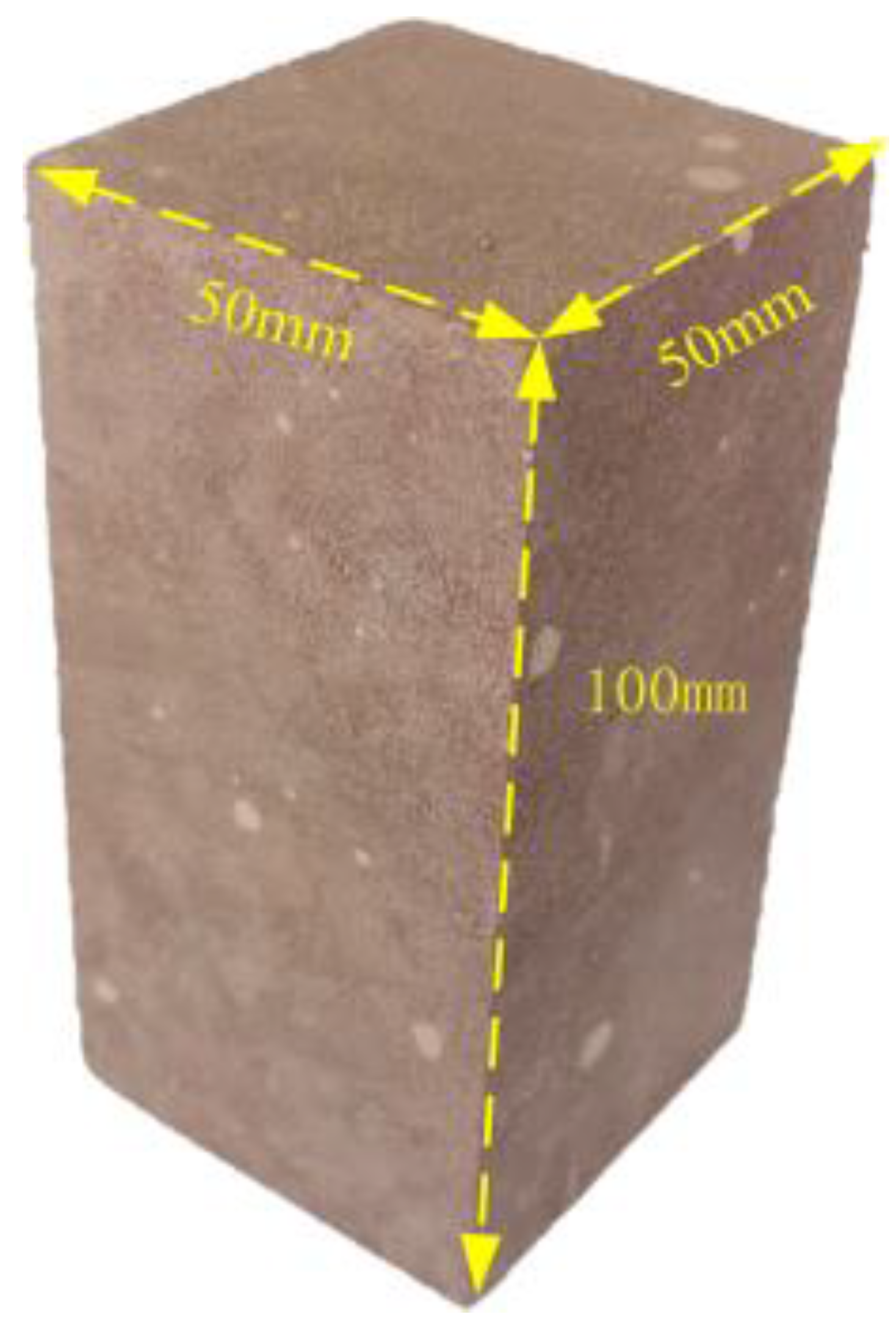
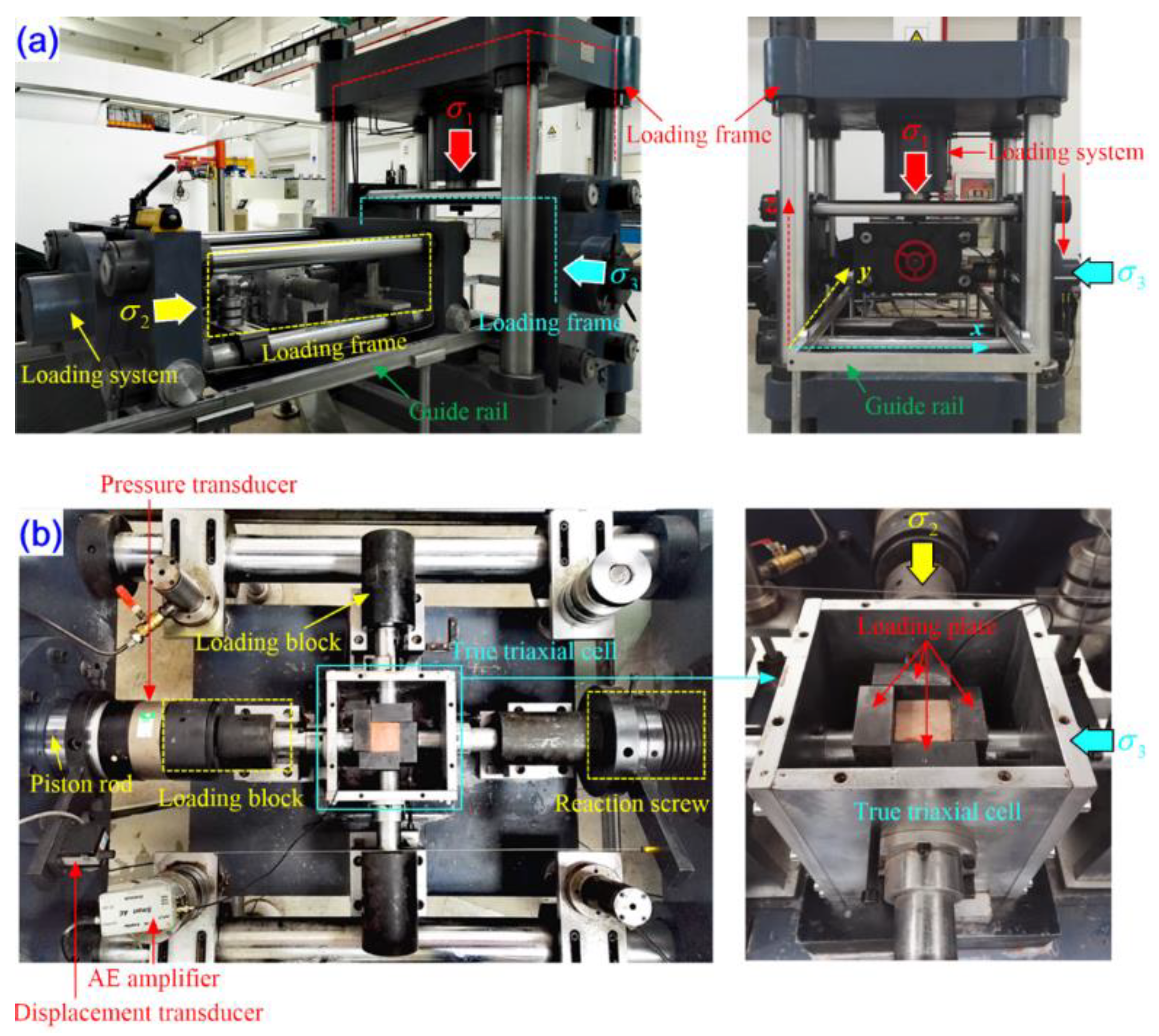
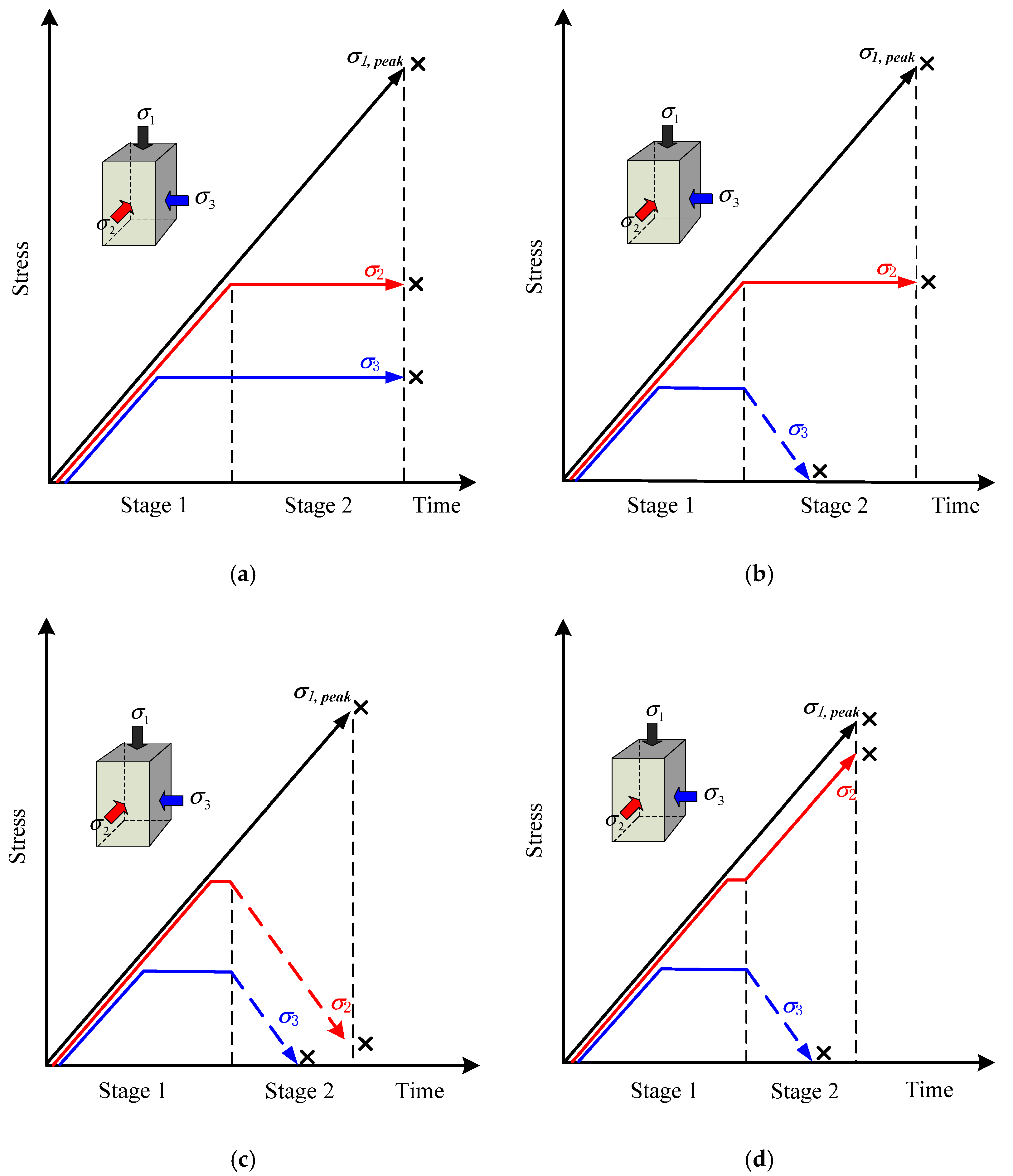
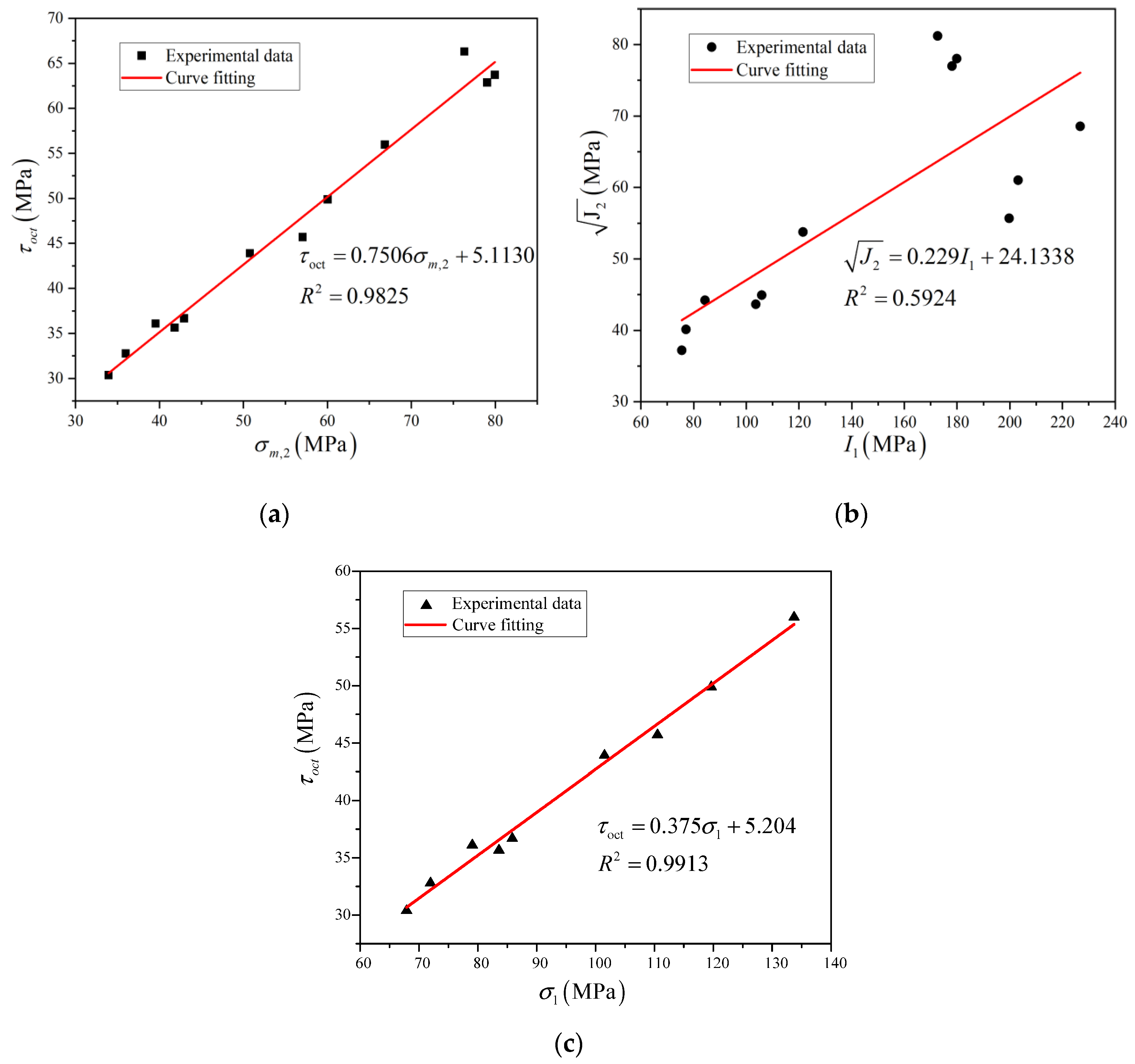
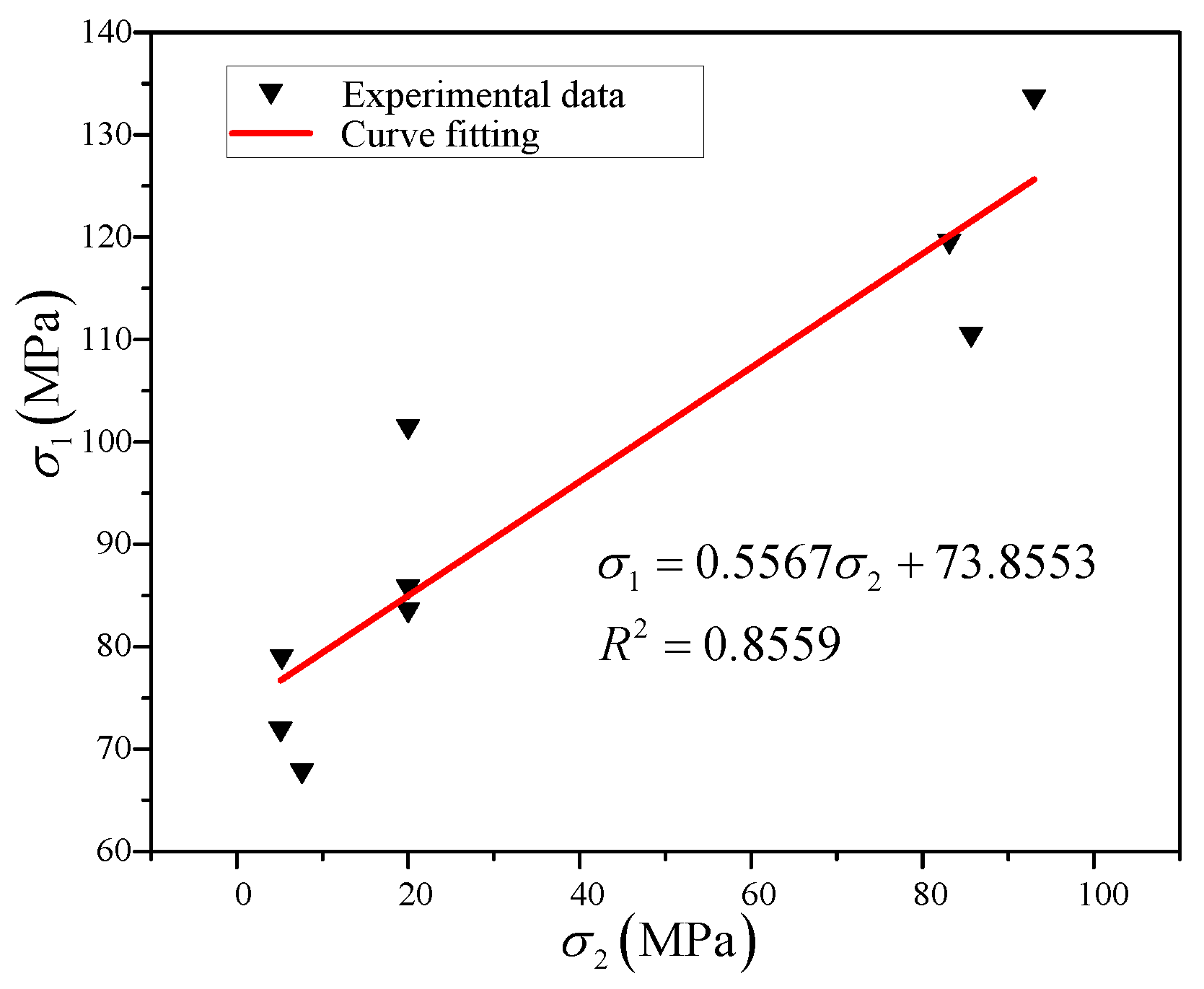

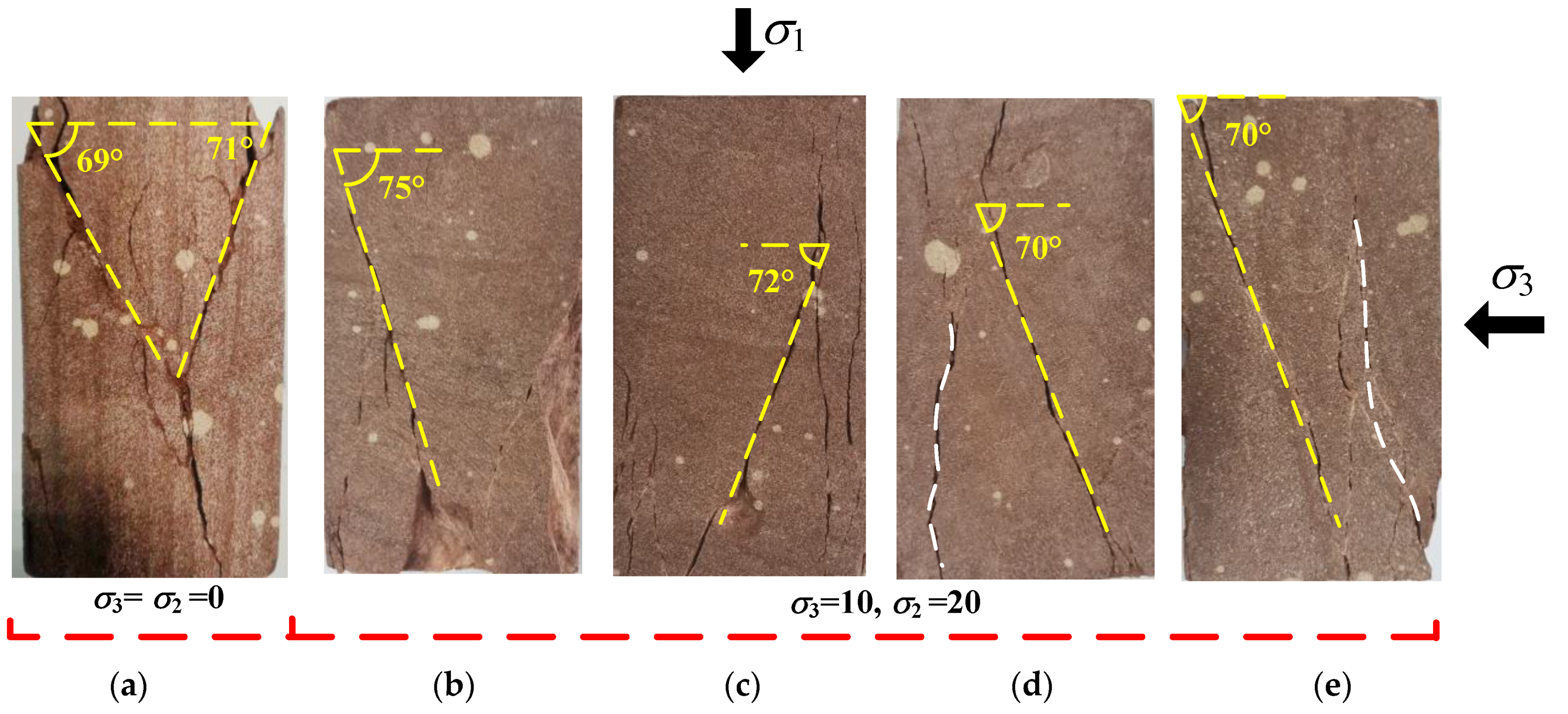
| Test Group | Sample No. | Sample Dimensions (mm) | Weight (g) |
|---|---|---|---|
| I | I-1 | 100.1 by 50.0 by 49.8 | 609 |
| I-2 | 100.2 by 49.8 by 50.1 | 610 | |
| I-3 | 100.1 by 50.1 by 49.9 | 612 | |
| II | II-1 | 100.4 by 50.0 by 49.8 | 614 |
| II-2 | 99.9 by 50.0 by 49.9 | 615 | |
| II-3 | 100.1 by 50.3 by 50.1 | 612 | |
| III | III-1 | 100.1 by 50.0 by 49.8 | 635 |
| III-2 | 100.0 by 50.0 by 50.2 | 602 | |
| III-3 | 100.2 by 50.1 by 49.9 | 608 | |
| IV | IV-1 | 100.1 by 50.0 by 50.0 | 611 |
| IV-2 | 100.2 by 49.9 by 49.8 | 613 | |
| IV-3 | 100.3 by 50.0 by 49.9 | 609 |
| Parameters | |
|---|---|
| Uniaxial compressive strength (MPa) | 64.7 |
| Cohesion (MPa) | 13.5 |
| Friction angle (°) | 44 |
| Strength Criterion | Slope | Intercept/MPa | Cohesion/MPa | Frictional Angle | R2 |
|---|---|---|---|---|---|
| Drucker–Prager | 0.2290 | 24.1338 | 14.09 | 33.99 | 0.5924 |
| Mogi–Coulomb | 0.7506 | 5.1130 | 8.96 | 52.76 | 0.9825 |
| New criterion | 0.375 | 5.204 | 12.20 | 41.33 | 0.9913 |
Publisher’s Note: MDPI stays neutral with regard to jurisdictional claims in published maps and institutional affiliations. |
© 2022 by the authors. Licensee MDPI, Basel, Switzerland. This article is an open access article distributed under the terms and conditions of the Creative Commons Attribution (CC BY) license (https://creativecommons.org/licenses/by/4.0/).
Share and Cite
Wang, S.; Wang, L.; Tian, J.; Fan, H.; Jiang, C.; Ding, K. An Experimental Study on the Effects of True Triaxial Loading and Unloading Stress Paths on the Mechanical Properties of Red Sandstone. Minerals 2022, 12, 204. https://doi.org/10.3390/min12020204
Wang S, Wang L, Tian J, Fan H, Jiang C, Ding K. An Experimental Study on the Effects of True Triaxial Loading and Unloading Stress Paths on the Mechanical Properties of Red Sandstone. Minerals. 2022; 12(2):204. https://doi.org/10.3390/min12020204
Chicago/Turabian StyleWang, Shuai, Lianguo Wang, Jiansheng Tian, Hao Fan, Chongyang Jiang, and Ke Ding. 2022. "An Experimental Study on the Effects of True Triaxial Loading and Unloading Stress Paths on the Mechanical Properties of Red Sandstone" Minerals 12, no. 2: 204. https://doi.org/10.3390/min12020204






